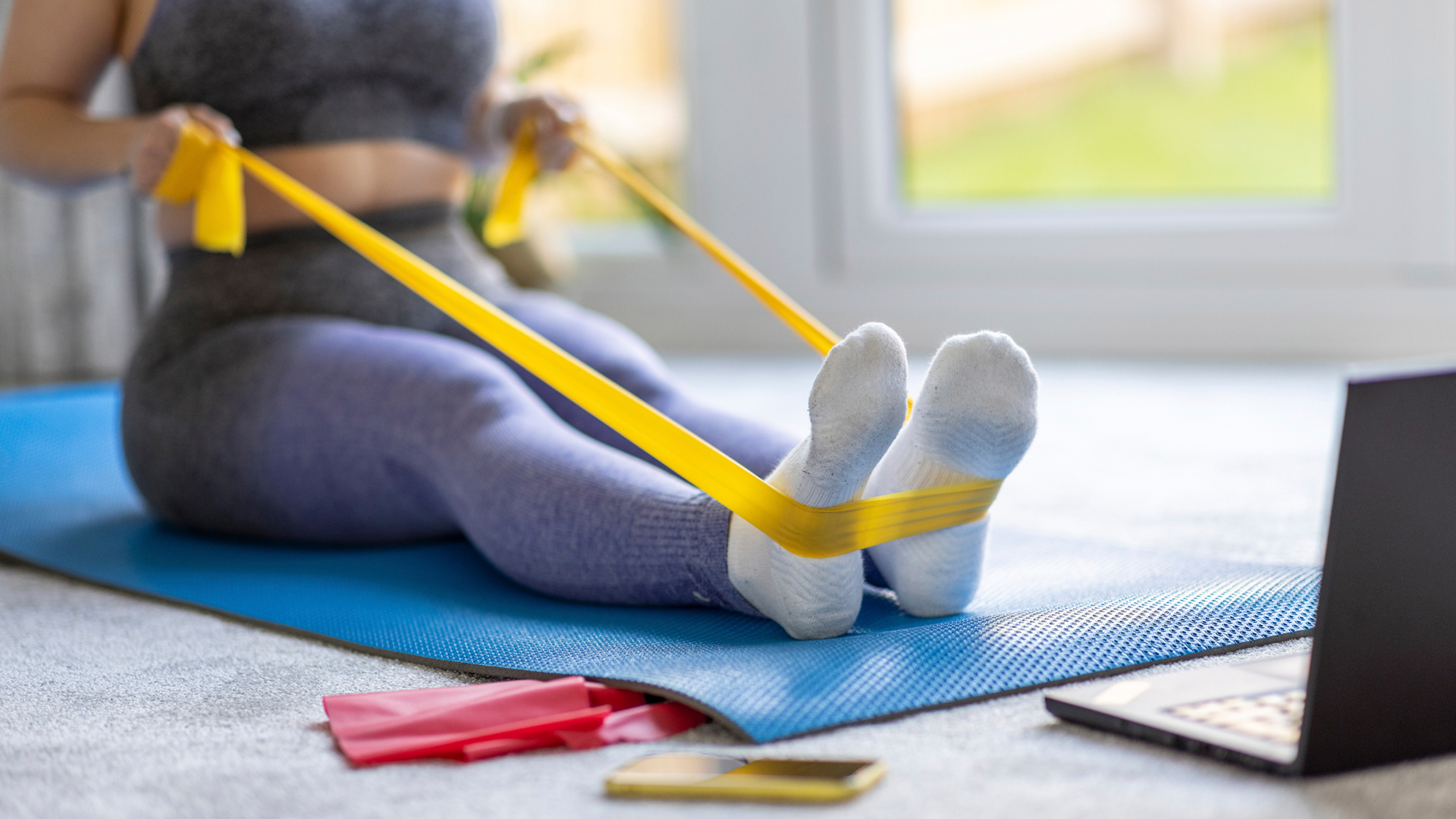How to use resistance bands: A guide for beginners
They’re affordable, portable and joint-friendly — we find out more about how to use resistance bands properly

Learning how to use a resistance band is relatively easy, and this kind of strength training is excellent for all fitness levels because it is low impact. The best resistance bands are made from latex, rubber or fabric and come in different tensions or resistance (stretchiness). This is usually light, medium, heavy or extra heavy.
Chartered physiotherapist Sherry Bingham told Live Science that resistance bands can be beneficial for everyone, from children and adolescents to adults and the elderly. “They can be used as an alternative to bodyweight training, or to add difficulty to the same bodyweight exercise,” she said. “They are easily transported, lightweight and great to travel with.”
To use, either stand on one side of the band and pull up the other (for example, to do a bicep curl); tie it around a tree or bannister to provide resistance for a chest press or shoulder stretch; or loop it over your legs to create tension during squats.
“Resistance bands recruit the ‘stabilizer’ muscles, which in turn support our larger muscles and joints as we move, helping reduce the risk of injury,” adds personal trainer Jen Skym, owner of Jeneration Fitness. “This makes them a safe and low impact option for beginners and older people. If you’re 40 or over, it’s also important to introduce this kind of resistance training into your fitness program, as studies have shown that it can help improve bone density.”
In this article we talk more to the expert about how to use resistance bands if you’re a beginner.
Why should I use a resistance band?
“There are loads of reasons to use resistance bands,” says O’Leary. “They are easy to take anywhere with you, which means that you can exercise even if you are on vacation. They’re also a great way of bringing resistance into your training if you are recovering from an injury, since they’re gentle on the joints. They are inexpensive and can be used to assist your movement and resist it, so it gives you plenty of options.”

Helen O’Leary is a chartered physiotherapist, Pilates instructor and the director of Complete Pilates in London, England. She started her career as a physiotherapist in professional men’s rugby and with Cirque du Soleil, before launching Complete Pilates.
One of the best reasons to use resistance bands is that they provide variety. You can use them for a full body workout, for mobility exercises or stretching, and, as with all strength training, they help to build muscle mass and tone.
Get the world’s most fascinating discoveries delivered straight to your inbox.
“This is because when we exercise, the muscles stretch and tear, and then the body repairs the muscle fibers and they grow and get stronger – a process known as hypertrophy,” explains Skym.
“The more lean muscle tissue you have, the higher your basal metabolic rate or BMR: the amount of calories required just to keep your body running,” adds Bingham. Having a higher BMR will increase the number of calories used and help reduce body fat, whereas a low BMR can make it harder to lose weight.
An American Physiological Society study found that over the age of 50, the rate of muscle fiber loss and wastage (known as atrophy) increases to 1% per year. Using resistance bands could help reduce this age-related muscle loss (known as sarcopenia) and improve flexibility, a Harvard Medical School study found.
“Resistance bands workouts also strengthen the back, shoulders and core muscles, which can improve posture and stability,” adds Skym.
What tension should I use?
When investing in a resistance band, you need to look at the strength or tension. They are often categorized as light, medium, heavy and extra heavy, so a beginner might want to start with a light band until they get used to the feeling.
So what tension should you use with your resistance band? “This is the great thing about resistance bands — mostly they come in packs with a variety of resistances in there,” says O’Leary. “This means that it is easy to progress an exercise as you get stronger.

“In general, legs need a stronger resistance as they are stronger. Arms often need a lighter band to ensure that your form is correct.
“If you are doing something like pull ups using a band, often you may want to go heavier so that it supports more of your body weight and helps you to do the exercise. As you get stronger, you can reduce the weight of the band.”
How to use a resistance band
You can loop a band around your arms or legs (for arm raises or squats), or stand in the middle of one and pull up against the resistance to do a bicep curl. “Like weights, they have different resistances to make your workout easier or harder,” says Skym.
“You can also secure a band to an anchor point, like a tree outside or beam in your home. Just make sure whatever you choose is sturdy so it stays put – chair legs for example are not a good idea as once you start stretching the band, as it’s likely the chair will come with you.”
What are the most common mistakes?
Bingham says stretching the band too quickly is a common mistake, and could risk an injury. “Use a mirror to watch your technique. What you think you’re doing and actually doing sometimes don’t marry up.”

Sherry Bingham trained at St George's Hospital Medical School in London and is registered with the Chartered Society of Physiotherapists. Since qualifying, she has worked predominantly in a variety of Government, NHS, Mental Health, Ministry of Defence and Private Practice positions.
Not choosing a heavy enough band, or picking one that is too short, is another thing beginners tend to do, says O’Leary.
“Try a few of your chosen exercises with the band and then adjust accordingly. This may mean wrapping it round your wrists to make it a little tighter, loosening it off or even choosing a heavier band.
“You also need to make sure that you keep an eye on your bands to check they are not fraying as they do wear out and will need to be replaced at some point. Be careful when you loop a band around something, as if it is sharp, this will cause degradation quicker. Finally, make sure you are putting the band in the right place.”

Are resistance bands better than weights?
According to Skym, you can pretty much do everything with a band that you can do with a weight. You are also at less risk of injury with bands over weights.
- Related: Best adjustable dumbbells 2022
Using resistance bands can be better than weight training in the sense that you are more in control of the tension. “You control how far you lean into the exercise, and how much your muscles are challenged as you move into your full range of motion. The more force you exert, the further the band will stretch, so it’s like adding more weights but without the hassle of swapping around with bits of kit,” says Skym.
Bands are also significantly cheaper than weights and are a good choice for beginners and those returning to exercise after a break. They are also really lightweight and portable, so you can pack them with you when you go on vacation or work trips.
But ultimately both bands and weights have their merits. “If you are looking for true strength gains (working 6-8 rep max exercises), then weights are better as you can add more load,” says O’Leary.
“However, if you are coming back from an injury, have recently given birth or are pregnant, if you have had an illness which has stopped you exercising or are new to exercise and want to gradually get into it, bands are a great choice. They are easier to use, which gives people more confidence, and you can choose how hard you want the resistance to go as you stretch the band.”

Maddy Biddulph is a freelance health and fitness journalist with over 26 years of experience working for consumer media in the US and UK. As a Level 3 personal trainer and weight loss advisor she is used to trying out and reviewing the latest health and fitness products. At Maddy Biddulph Personal Training, she runs one-to-one and small group sessions, as well as group exercise classes. She specializes in mobility work with seniors and runs regular chair workouts in her hometown of Oxford.


